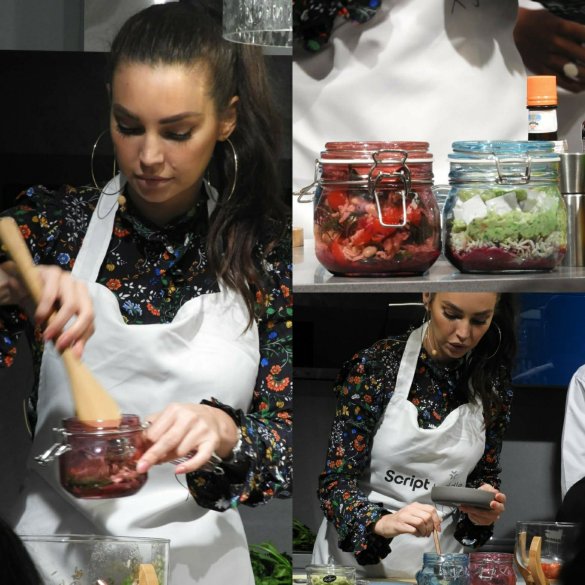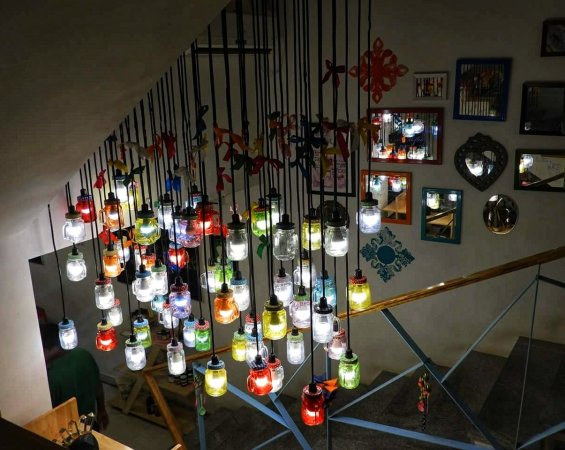I’m sure most foodies would know Sarah Todd, especially those who have been regularly following MasterChef Australia. For the uninitiated, Sarah Todd was the finalist at MasterChef Australia 2014, with a huge fan following from India, thanks to her attempting a few India-inspired dishes on the show. Recently, when The Little Black Book (LBB) – Bengaluru offered me a chance to participate in a masterclass with Chef Todd, I grabbed the opportunity with both hands. I’m so very glad I did – it turned out to be such a fun afternoon!
The event was held at Script, a concept kitchen and workshop venture by Godrej. This was my first time visiting Script, and I found it to be a charming venue, a must-visit for food enthusiasts in the city.

Sarah Todd’s career story is nothing short of inspiring. She became a model at the young age of 18, after which a decade-long career on the ramp followed. In the course of her work with brands like Hugo Boss, Pantene and Gucci, which entailed extensive travels across the globe, she began to develop a passionate love for food culture. In a candid moment at the masterclass, Sarah said, “One day, when I was still a model, I had to put up the exact same pose about 15 times, so the photographer could get the right shot. That was a sort of turning point in my life. It was then that I began to ask myself – ‘What am I doing with my life? Is this what I really want to do?‘”
The moment sparked some sharp introspection on Sarah’s part, and she decided she wanted to delve deeper into food. She went on to enroll herself at the famed Le Cordon Bleu, and trained in French cooking. For years, she worked as a chef, training alongside Michelin-star chefs. In 2014, she participated in MasterChef Australia, which, she claims, was another huge turning point in her life. She discovered herself, her cooking style, while at the show. She found that she leant more towards wholesome, healthy food that she could serve to her family, rather than elaborate meals that looked like magical masterpieces.
Apparently, Sarah’s love for Indian food began when she started dating Devinder Garcha, an Indian. While at MasterChef Australia, Sarah prepared a few Indian dishes, which earned her a fan following of over 50,000 Indians overnight. The next morning, when she logged into her social media, this had her completely stunned. She visited India soon after, in an attempt to figure it all out, and fell deeper in love with Indian food. She went on to open Antares, her restaurant in Goa, followed by another, The Wine Rack, in Mumbai. In the intervening years, Devinder and Sarah became parents to Phoenix, a lovely son. “I became all the more obsessed with food after becoming a mom. I wanted my son to taste everything, and I wanted to make everything myself. I wanted to know exactly what I was feeding him,” she said at the masterclass.

Sarah’s wonderful plating skills have always amazed. At the masterclass, she wowed everyone by demonstrating the beautiful plating of two dishes – a Citrus & Cocoa Tart and an Avocado Open Sandwich. “We eat with our eyes first. If you are presented the exact same dish in two different plates – one just dumped on the plate, and the other presented artistically – I can guarantee you will eat more of the latter. Presentation is of considerable importance,” she said at the masterclass.
“Any kind of food can be presented artistically. Anyone can do it. You need to break free of the shackles in your mind first. Just let loose, and let your creativity rein in, while you are plating,” said Sarah.
“Taste is just as important as presentation,” Sarah said. “For me, a dish just cannot just look very pretty, but be lacking in flavour. It has to be bursting with flavour, too!,” she added.

At the masterclass, Sarah demonstrated the making of two wholesome salads in jars, perfect for busy-workday lunches.
She spoke of how a cook needs to take care of three core things for a dish to be successful – flavours, textures and presentation. “A great dish has to have a variety of flavours, to keep the eater interested – sweet, sour, saltiness, spiciness and some umami, everything has to be in balance. There have got to be at least a couple of different textures to the dish. Lastly, of course, it has to be presented beautifully,” she said.

Speaking about her bond with India at the masterclass, Sarah said, “India is special. Indian food is so diverse, so amazing! I am constantly awed by the foods that I go on discovering in India – every new place I visit in this country, I end up with a new favourite food. There’s so much yet for me to learn, to discover. It is tough for me to point out just one favourite Indian food!”
She spoke of how she does not want either Antares or The Wine Rack to be categorised as ‘an Australian restaurant’. “I want to cook Indian food, giving it my personal touch,” she said. “I can’t ever dream of competing with authentic Indian food, the way it has been cooked in Indian families over generations. How can one ever compete with that?! I want to take Indian food, and make it my own. I see I am making a difference that way, too,” she said at the masterclass.
“I cook with the special, indigenous ingredients of the region, at both my restaurants. I make sure the ingredients are seasonal and procured fresh. Indian cuisine has a whole lot of wonderful ingredients that I am discovering – it is such a fun cuisine to be creative with!,” Sarah said.
She then went on to demonstrate the making of a fruity non-alcoholic drink, just perfect for hot summer days, at the masterclass.

All through the masterclass, Sarah’s personality shone out. What a humble, down-to-earth, friendly and warm person!
The question-and-answer session with the audience at the end of the masterclass was what I enjoyed the best. It gave me a glimpse of the feisty, determined side of Sarah, the brains and talent behind the pretty face, the humane side of her that is trying to overcome her own shortcomings, the mommy in her, the career woman in her who is trying to make a difference in a world dominated by men.
All in all, it was a lovely afternoon, shared with fellow food enthusiasts from across the city. A fun time was had by everyone, I’m sure.
Now, I can’t wait to get to reading Sarah Todd’s blog and trying my hands at some of her recipes!












